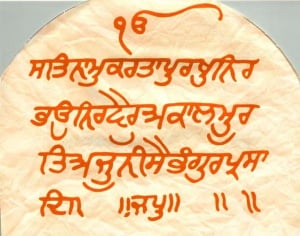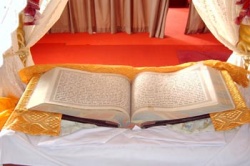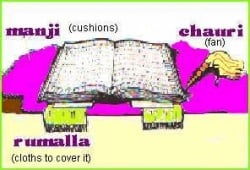Guru Granth Sahib ji
- Main article: Guru Granth Sahib
Text for children
The Guru Granth Sahib is more than just the Sikh Holy book; it is respected by the Sikhs as a "perpetual Guru" or "Ever-present guide". If it is not in use it is wrapped in decorative silks and richly embroidered cloths and placed on a platform.
Before his death in 1708, Guru Gobind Singh, the 10th Guru ordained that from then on the sacred "Granth" (holy Book) should be recognised as the manifest body of the Gurus - and hence the name Guru Granth Sahib Ji. It was first compiled by Guru Arjan in 1604 and was then known as the "Adi Granth" or "first Book".
During the day the book is opened and placed on a small dais called the Manji Sahib with a canopy above and rests on several cushions. If it is not being read it may be covered with a cloth called a Rumalla. Whilst it is being read a fan called a Chaur Sahib may be waved over it to show sign of respect and honor for the holy message. Sikhs usually place an offering in cash or kind or both as they approach the holy Granth, and bow down low on their knees to show their respect for its message. During a religious service, a 'Granthi' (one who reads the Granth) or a sewadar (volunteer) remains in constant attendance and holds a Chaur (a symbolic whisk of sovereignty) which he occasionally moves over the Granth.
The book is made up from the sacred writing of six Gurus. It contains 1,430 pages and 5,894 hymns which are arranged in 31 Ragas (musical measures). All copies of the Granth Sahib always contain exactly the same text and in the same order as originally written by the Gurus. The Granth is written in Gurmukhi (literally "from the mouth of gurus") script and the predominant language used is Punjabi. A unique feature of the Granth is that it also contains a good number of passages or verses from non Sikhs i.e. Muslims, Hindus and even so called 'untouchables' saints. The Granth is treated like a live Guru; with great respect. Wherever the Granth is can be considered a religious meeting place for Sikhs.
The Mool Mantra is the opening hymn or Shabad of the Guru Granth Sahib. It is a fundamental statement of Sikh belief.

- IK OKAAR There is only one God
- SAT NAAM Truth is his name
- KARTA PURKH He is the creator
- NIRBHAU He is without fear
- NIRVAIR He is without hate
- AKAAL MOORAT He is timeless and without form
- AJOONI SABHANG He is beyond death - the enlightened one
- GUR PARSAD He can be known by the guru's grace
On special occasion, a full continuous reading the whole of the Guru Granth Sahib takes place - this is called an Akhand Paath. The reading by a relay of competent readers in 2 hour shifts takes 48 hours and is done on special occasions such as on the birth of a child; a birthday; or moving house as well as before religious festivals. Readers take it in turns to read the text, man and women will take part. Full reading of the Granth in a more leisurely fashion over about ten days is called the Sahaj Paath. It may be read either at the Gurdwara or at home.
The full text of the Granth has now been translated into many languages, including English. Several versions can be found and a few can be read over the internet at Srigranth.org, SikhitotheMAX.com and sikhnet.com
Also See


